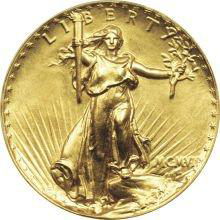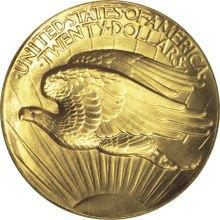 1907 Ultra High Relief, $20 Lettered Edge PR69 PCGS. While the sun never set on the British flag in the 19th century, the 20th century was definitely "The American Century." After the assassination of William McKinley in 1901, President Theodore Roosevelt typified the American spirit: young, vibrant, and energetic. Roosevelt's interest in the appearance of America's coinage is not coincidental, as he had written an essay some 20 years previously on the coinage of Gouverneur Morris. Nor was his interest merely that of a collector or enthusiast of coinage. It is not an overstatement to say that Roosevelt was prescient in his understanding of the role the United States would play in the 20th century. To that end, he sought a new appearance for American coinage, one that would project to all the nations of the world the vision and dynamism of the United States. Just as mint officials from the 1790s understood the importance of the exact weight of all silver and gold coins and how that exactness affected the acceptance of U.S. coins abroad, Theodore Roosevelt understood the importance of the appearance of American coins. To that end, he challenged America's foremost sculptor to alter the coinage then in circulation, coins Roosevelt considered to be artistically of "atrocious hideousness."
1907 Ultra High Relief, $20 Lettered Edge PR69 PCGS. While the sun never set on the British flag in the 19th century, the 20th century was definitely "The American Century." After the assassination of William McKinley in 1901, President Theodore Roosevelt typified the American spirit: young, vibrant, and energetic. Roosevelt's interest in the appearance of America's coinage is not coincidental, as he had written an essay some 20 years previously on the coinage of Gouverneur Morris. Nor was his interest merely that of a collector or enthusiast of coinage. It is not an overstatement to say that Roosevelt was prescient in his understanding of the role the United States would play in the 20th century. To that end, he sought a new appearance for American coinage, one that would project to all the nations of the world the vision and dynamism of the United States. Just as mint officials from the 1790s understood the importance of the exact weight of all silver and gold coins and how that exactness affected the acceptance of U.S. coins abroad, Theodore Roosevelt understood the importance of the appearance of American coins. To that end, he challenged America's foremost sculptor to alter the coinage then in circulation, coins Roosevelt considered to be artistically of "atrocious hideousness."
 It seems particularly appropriate that exactly 100 years after Roosevelt and Augustus Saint-Gaudens first met and discussed making a try at the high relief coins of the ancient Greeks, the finest known example of the Ultra High Relief is being offered for sale as part of the finest collection of Saint-Gaudens coinage ever sold at public auction. Needless to say, this is a visually stunning coin. The surfaces are virtually perfect, as one would expect from a coin graded PR69; nevertheless, it is somewhat surprising to see that any coin has been so well cared for since striking 98 years ago.
It seems particularly appropriate that exactly 100 years after Roosevelt and Augustus Saint-Gaudens first met and discussed making a try at the high relief coins of the ancient Greeks, the finest known example of the Ultra High Relief is being offered for sale as part of the finest collection of Saint-Gaudens coinage ever sold at public auction. Needless to say, this is a visually stunning coin. The surfaces are virtually perfect, as one would expect from a coin graded PR69; nevertheless, it is somewhat surprising to see that any coin has been so well cared for since striking 98 years ago.
As mentioned in the introductory page, Ultra High Reliefs were struck seven times on a medal press in order to fully bring up all the details in the dies. Also, they were annealed between strikings. This annealing process heated the coin to a cherry-red color and then cooled in a weak solution of nitric acid. The result was a coin that had a surface of nearly pure gold. This annealing process gives Ultra High Reliefs an even more distinctive appearance. Each side is bright, shimmering pure gold with no variation between fields and devices. This no-contrast appearance is suggestive of proof coinage that the mint struck from 1901-1903, but that was a conscious effort to not give proofs a cameo appearance and, of course, annealing was not a part of the striking of those coins. To reiterate, the surfaces are bright, and we make mention of this a second time as the Ultra High Relief has surfaces unlike any other American coin because of the annealing process. The Ultra High Relief transcends terms such as "satiny" or "frosted," when discussing the finish. It is simply pure, glittering gold. Undoubtedly this contributes to the popularity and desirability of the 19-20 coins that are known, but its desirability goes far beyond this. The lore of the Ultra High Relief includes the meticulous striking conditions under which these pieces were produced, their production by presidential order, and the time spent to strike each coin.
The story of the Ultra High Relief is one that also seems to have a villain. The story has been told by Walter Breen, Don Taxay, and countless others of the resistance by Charles Barber to outside interference and the production of a non-mint designed coin. As good as this story may be, an objective look at the reality of the production of these coins and the subsequent High Reliefs and Low Relief pieces suggests that Charles Barber may not have been such a vain protagonist as he was a Chief Engraver who knew the impracticality of striking such coins for commercial distribution.
As stated above, the surfaces of this piece are essentially perfect, as one would infer from the assigned grade. We see no contact marks on either side, and this cataloger has looked long and hard with a 16-power loupe. There is, however, a curious and distinctive area on this piece that will distinguish it from other Ultras: on the lower reverse along the wire rim and just above it, between 6 and 7 o'clock, there is a line of copper alloy that was apparently not removed in the annealing process. The fields show very faint, swirling die polish marks and, of course, the Capitol building is much smaller than on any subsequent strikings including the regular High Reliefs.
The Ultra High Relief was the first coin to break the $200,000 price barrier and that was in the Ullmer Sale in 1974. The Ultra has few peers in terms of desirability and, in our opinion, none that compare in historic or numismatic importance. Its only rival is the 1933 double eagle, bookends in this widely collected series, and the only twenty dollar that is more valued than the Ultra High Relief--but then, only one 1933 is legal to own. This piece is one of the Lettered Edge strikings, but the lettering is not visible because of the PCGS encapsulation. It is tempting to call the Ultra High Relief "first among equals," but in fact, it has no equal among regular High Reliefs or lowered relief business strikes. Because the Ultra has a unique and distinctive appearance, its only peers are other Ultra High Reliefs, and according to the NGC Census and PCGS Population Report, this is the only PR69 in existence. (The NGC Census Report shows another PR69, but this is the same coin, apparently the flip was never returned to NGC and so the duplicate entry remains). We feel confident stating that this particular coin will set a new record for an Ultra High Relief when sold as part of the Phillip Morse Collection.
Purchased by NERCG/Jim Halperin as part of "The Million Dollar Set" (Captain North) of 1907 coinage from Stack's in April 1980; Boston Jubilee Auction (NERCA, 7/80), lot 323; Trompeter Collection; Heritage private sale, 1999